Table of Content
TABLE OF CONTENTS

In the current aggressive business condition, utilizing the data resources of an association is vital to building effective worldwide business endeavors of the future. Multiple organizations burn through a huge number of dollars on business knowledge/information warehousing (BI/DW) arrangements, yet these activities have yielded not as much as expected rate of return (ROI) as they have neglected to distinguish and address the basic angles impacting the result of these BI activities.
Business Intelligence (BI) Editions come in all shapes and sizes. Some accentuate the design, while others tout their showy interface. Some cost a huge number of dollars, while others cost hundreds.
A decent BI edition gets consistent upgrades, and along these lines, dependably stays current with the most recent innovation and patterns. Each great Business Intelligence software or tool must incorporate certain important features. This blog post details on a BI software, Tableau.
Tableau extends the value of the data across any organization’s vertical. It empowers ones business with the freedom to explore data in a trusted environment without limiting it to pre-defined questions, wizards, or chart types. With its ease of deployment , robust integration, simplicity of scalability, and excellent reliability any organization no longer have to choose between empowering the business or protecting its data- with Tableau you can finally do both.
Following guidelines traces highlights and capabilities of Tableau software, and isolates each featureinto four unique classifications.
1. High-level highlights
1.1 Open Architecture
A generally overlooked element, Tableau design stays a standout amongst the most basic parts of Business Intelligence. A few sellers construct their products all alone restrictive engineering, while others expand on open design and systems.
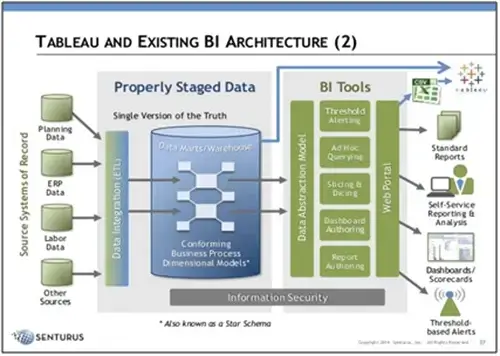
1.2 Wide database support
While a few arrangements just help a solitary database or stage, Tableau BI programming must help any database or stage. Going above and beyond, it should likewise construct applications that can pull information from different wellsprings of information. Tableau 10 includes even more data source options, as given below:
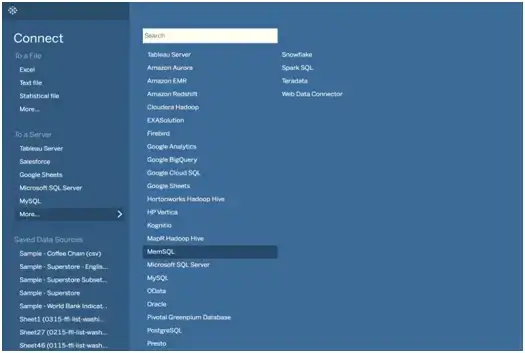
Figure 1: Tableau v10
1.3 Real-time information
Some BI programming conveys day-old or even week-old information. Tableau makes applications that convey constant information straightforwardly from your database. Why is this so imperative? Business Intelligence encourages you to make snappy, educated choices in view of the most current information conceivable. An absence of constant information blocks basic leadership and significantly confines the benefits of BI. For example: The City of Boston, for example, is using Tableau in a pilot program in the mayor’s office to set up dashboards for various departments in the city. If it works as envisioned, the mayor will be able to walk into a control center that contains screens showing the dashboards and not only get an idea of what’s happening in those departments at any given time, but also ask questions about particular indicators on the dashboards and get answers while standing in front of the screens.
1.4 Self-benefit capacities
In the past, the IT division controlled detailing and BI capacities inside the association. Nowadays, Tableau programming incorporates self-benefit abilities that let end clients make their own particular BI and announcing applications.
1.5 Mobile support
Modern Business Intelligence programming must traverse all gadgets and stages. Tableau give support all set of mobile devices on various operating system: IOS, Android, etc.
1.6 Support for Data-mart or Data-Warehouses
Data-store and information stockroom structures permit the Tableau software to work with information from numerous source frameworks. They pull information from transactional databases that maintain the business and utilize the power of OLAP for detailed investigation required for ad-hoc reporting and analysis.
2. Security highlights
2.1 Application level security
Application level security gives you a chance to control Tableau application access on each client part or per-client premise. This commonly incorporates a part based framework, which shows distinctive menu choices to various clients in light of their part.
2.2 Row-level (or multi-inhabitant) security
A basic part of Tableau BI and announcing applications, multi-occupant security gives you a chance to control information access inside a solitary application at the column level. As delineated in the picture underneath, this implies various clients get to a similar application, yet see the diverse information.
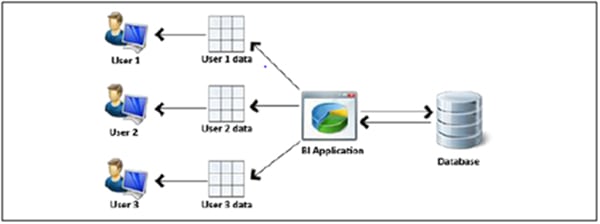
Figure 2: Multi-occupant Security
2.3 Single sign-on
Tableau’s session/client confirmation process, single sign-on (SSO) gives clients a chance to enter their name and secret key in just a single place and access numerous related applications. It validates the client for every approved application and wipes out login prompts when exchanging between applications in a solitary session.
2.4 User benefit parameters
User benefit parameters let you customize highlights and security to singular clients or client parts. Spared to a client's profile, these client benefit parameters control client particular highlights all through each tableau BI application. Why is this so essential? Client benefit parameters offer wide control over numerous application viewpoints. They let you control the look and feel, include or shroud client alternatives, restrain client abilities, and that's only the tip of the iceberg. For example, assume your organization made a web turntable. Client benefit parameters could control which clients have an expert to trade that rotate table to a PDF report or spreadsheet. Unapproved clients couldn't see the "fare" choice in the application.
2.5 Flexible authentication choices
Many organizations as of now utilize numerous application validation sources. For example, your CRM framework may confirm clients against one client table, while your email framework may utilize a totally extraordinary confirmation source. Tableau BI programming gives adaptable confirmation options– giving you a chance to validate your applications utilizing whatever authentication sources you as of now have set up.
2.6 Application activity evaluating
Tableau Application activity auditing gives IT staff a chance to log end-client movement for flag/signoff exercises. This gives IT divisions a chance to screen when clients sign in, which applications they get to, and when they log off.
3. Must have features
3.1 Ad-hoc reporting
Ad-hoc reports let end users make and share work at run time. Clients select the information components they wish to find in the report at run-time, and afterward, send out the report to an organization of their picking or email the answer to different clients specifically from the web program.
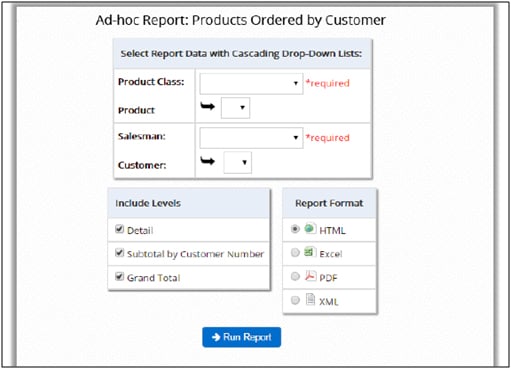
3.2 Ranking report
Tableau report makes variable rankings, over numerous measurements, while indicating different choice criteria at run-time. For instance, assume you need a report that rundowns your main 25 best clients of the most recent year. Or, then again, assume you need the best (or base) 5 sales representatives a month ago. A positioning report makes this basic.
3.3 Executive dashboards
A dashboard gives a continuous perspective of your business utilizing numerous, simple to-peruse diagrams. Tableau Dashboards offer basic information redid to every official's obligations and zones intrigue. For instance, a CEO needs diagrams showing income over the previous year, month, and week. The client benefit supervisor needs charts showing normal time expected to determine issues.
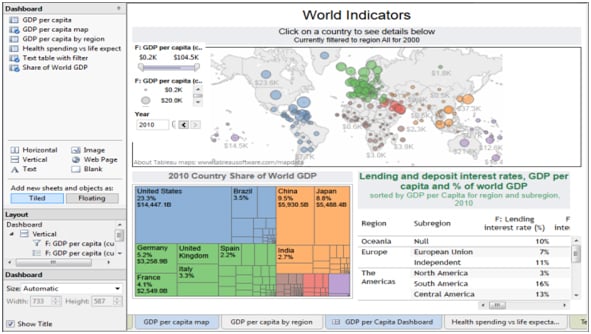
Figure 3: Dashboard
3.4 Pivot table/OLAP
Pivot tables naturally extricate, arrange, and condense information. Frequently utilized for investigating information, making correlations, and finding patterns, the adaptability offered by rotate tables makes them a standout amongst the most prevalent BI applications.

Figure 4: Pivot Table
3.5 What if-investigation
Tableau application gives you a chance to evaluate potential business changes before you make them. Utilizing past information, it shows how extraordinary changes may influence certain parts of your business. For instance, imagine a scenario in which you raised costs by 10%. Imagine a scenario in which you brought down costs and expanded amount.
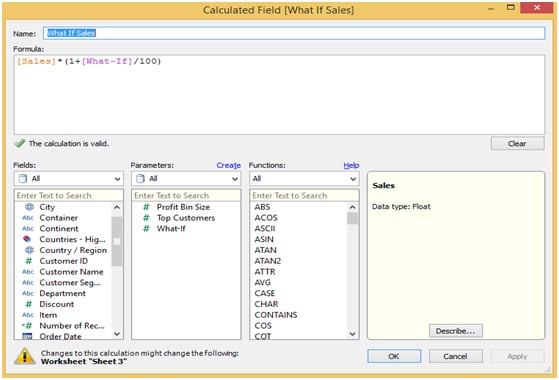
3.6 Geospatial/mapping applications
This application takes your topographical information and showcases it graphically on a guide. It enables organizations to pick up area based understanding - either to pick up an aggressive edge, enhance authoritative execution administration or both.
4. Advanced highlights
4.1 Intelligent alerts
Tableau threshold server application naturally sends an email or SMS message to the suitable party when information comes to a pre-characterized edge. For example, shrewd cautions can in a flash advice the CEO whenever a client wipes out their record, or whenever deals numbers achieve unusual levels.
4.2 Collaboration
As we gained from the ascent of online networking, the web gives the ideal joint effort stage. This idea makes an interpretation of consistently to Business Intelligence. Tableau BI applications will join remarking and let you interface with other collaborators straightforwardly inside the application.
4.3 Cloud-Compatibility BI
Most investigators and specialists concur on one point: Cloud processing is what's to come. Tableau on the cloud guarantees close to 100% uptime and versatility while dodging the exertion/cost of in-house equipment. Tableau Online is your analytics platform fully hosted in the cloud. Publish dashboards and share your discoveries with anyone. Invite colleagues or customers to explore hidden opportunities with interactive visualizations and accurate data, all easily accessible from a browser or on the go with mobile apps.
4.4 Built-in ETL
Tableau ETL software lets you extricate information from different source frameworks, change it into a solitary organization, and load that information into an objective database. They give end clients a basic approach to incorporate information from different areas in a distributed storage structure yet give a unified view for users.
Tags
Data Activation
Varun Sodhi
Senior Consultant
He is part of the Business consulting team engaging with organizations to help them build their digital strategy.
-2.jpg?width=240&height=83&name=Menu-Banner%20(5)-2.jpg)
.jpg?width=240&height=83&name=Menu-Banner%20(8).jpg)

